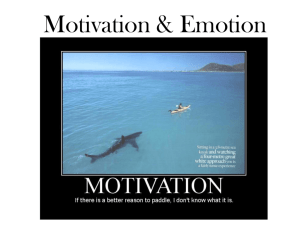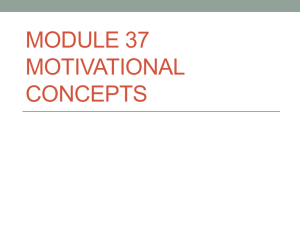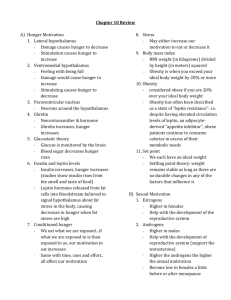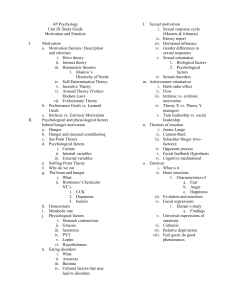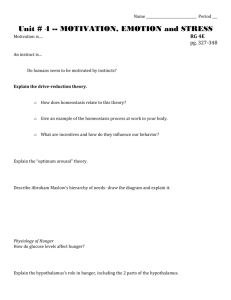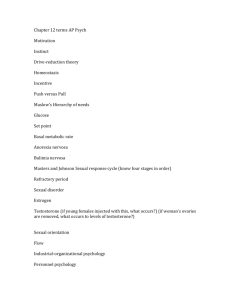Chapter 9 Editable Lecture Notecards
advertisement
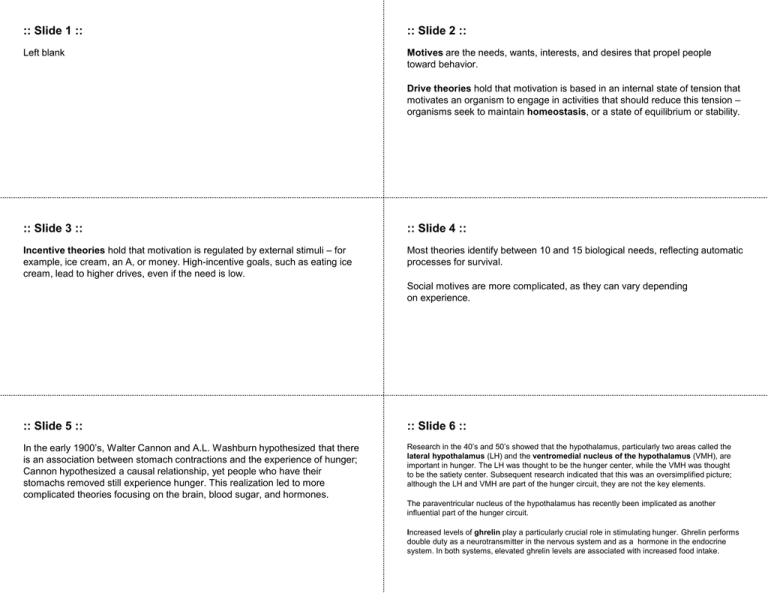
:: Slide 1 :: :: Slide 2 :: Left blank Motives are the needs, wants, interests, and desires that propel people toward behavior. Drive theories hold that motivation is based in an internal state of tension that motivates an organism to engage in activities that should reduce this tension – organisms seek to maintain homeostasis, or a state of equilibrium or stability. :: Slide 3 :: :: Slide 4 :: Incentive theories hold that motivation is regulated by external stimuli – for example, ice cream, an A, or money. High-incentive goals, such as eating ice cream, lead to higher drives, even if the need is low. Most theories identify between 10 and 15 biological needs, reflecting automatic processes for survival. Social motives are more complicated, as they can vary depending on experience. :: Slide 5 :: :: Slide 6 :: In the early 1900’s, Walter Cannon and A.L. Washburn hypothesized that there is an association between stomach contractions and the experience of hunger; Cannon hypothesized a causal relationship, yet people who have their stomachs removed still experience hunger. This realization led to more complicated theories focusing on the brain, blood sugar, and hormones. Research in the 40’s and 50’s showed that the hypothalamus, particularly two areas called the lateral hypothalamus (LH) and the ventromedial nucleus of the hypothalamus (VMH), are important in hunger. The LH was thought to be the hunger center, while the VMH was thought to be the satiety center. Subsequent research indicated that this was an oversimplified picture; although the LH and VMH are part of the hunger circuit, they are not the key elements. The paraventricular nucleus of the hypothalamus has recently been implicated as another influential part of the hunger circuit. Increased levels of ghrelin play a particularly crucial role in stimulating hunger. Ghrelin performs double duty as a neurotransmitter in the nervous system and as a hormone in the endocrine system. In both systems, elevated ghrelin levels are associated with increased food intake. :: Slide 7 :: :: Slide 8 :: Other research has focused on the role of blood glucose and digestive regulation on hunger; when blood sugar goes down, hunger goes up. Glucostatic theory proposed that fluctuations in blood glucose level are monitored in the brain by glucostats – neurons sensitive to glucose in the surrounding fluid. It appears likely that hunger is regulated, in part, through glucostatic mechanisms. Clearly, hunger is related to biology; however, it is also regulated by environmental factors like learned preferences. Studies show that people like foods that are familiar to them; dog meat is a delicacy in some parts of the world. Exposure and observational learning appear to play a part in what we like to eat. Learning also appears to influence when and how much people eat. Hormones circulating in the blood also appear to be related to hunger. Insulin, secreted by the pancreas, must be present for cells to use blood glucose. Increases in insulin increase hunger, and the mere sight and smell of food has been shown to increase insulin.Recently, a new hormone, leptin, has been discovered to be released from fat cells into the bloodstream. Leptin is believed to signal the hypothalamus about fat stores in the body, causing decreases in hunger when fat stores are high. :: Slide 9 :: :: Slide 10 :: William Masters and Virginia Johnson conducted groundbreaking research in the 1960s, using physiological recording devices to monitor the bodily changes of volunteers engaging in sexual activity. They outlined four stages in the sexual response cycle. The excitement phase is the initial arousal, which escalates quickly. Muscle tension, respiration rate, heart rate and blood pressure increase. Vasocongestion – engorgement of blood vessels occurs in the genitals. [Click to continue.] The plateau phase occurs when physiological arousal continues to build, but at a slower pace. [Click to continue.] The orgasm phase occurs when sexual arousal reaches its peak intensity and is discharged in a series of muscular contractions that pulsate through the pelvic area. The subjective experience of orgasm is very similar for men and women, although women can be multi-orgasmic. On the other hand, they are more likely to engage in intercourse without experiencing an orgasm. [Click to continue.] The resolution phase is characterized by subsiding physiological arousal. Men experience a refractory period after orgasm, when they are largely unresponsive to further stimulation. This may last from a few minutes to a few hours and increases with age. :: Slide 11 :: :: Slide 12 :: Evolutionary analyses of human sexual motivation have focused on the difference between male and female parental investment. If males are to maximize their number of fertile offspring, they might do so by mating with as many females as possible. Females, on the other hand, must carry and then feed their offspring, who will not survive without considerable investment on her part. This difference in required investment has been used to explain other gender differences in sexual activity and preferences. Because female fertility is not itself observable, evolutionary theorists suggest that the best standin for female fertility are characteristics like youth and physical features that males have come to regard as beautiful because they predict fertility. Males therefore should have a stronger preference than do females for mates that are young and attractive. Conversely, females should be more interested than are males in a mate who has resources to invest in children. Because resources often come with age, females should generally prefer a mate older than themselves and with characteristics predictive of future success, such as intelligence, ambition, and diligence. Males think more about sex, and are more motivated to seek sex with many different partners, than are females. The resemblance between evolutionary psychologists’ predictions and common stereotypes has led to intense criticism of these theories, and it is certainly the case that these evolutionary considerations are not the only possible explanation of the data. More research is needed in this area. :: Slide 13 :: :: Slide 14 :: Sexual orientation refers to a person’s preference for emotional and sexual relationships with individuals of the same sex (homosexuality), the other sex (heterosexuality), or either sex (bisexuality). Many environmental theories explaining homosexuality have been put forth historically. Freud held that a person must identify with the same sexed parent, or homosexuality results. Behaviorists assert that homosexuality is learned through conditioning. Research has failed to support either theory. What has been found is that most men and women with homosexual orientations can trace their leanings back to early childhood, suggesting a biological basis. Recent conceptualizations of sexuality hold that homosexuality and heterosexuality are endpoints on a continuum. Biological research suggests that there is a genetic predisposition to homosexuality, possibly based on the X chromosome. Anatomical differences between gay and straight men in the size of the anterior hypothalamus have also been found. This structure is larger in men than in women, and this study showed that gay men had a 50% smaller AH than straight men. Data on the prevalence of homosexuality suggests that 5-8% of the population may have a homosexual orientation. Some theorists believe that anatomical brain differences such as these may be due to the organizing effects of prenatal hormones on neurological development. The interactionist view holds that genes and prenatal hormones shape a child’s temperament, which initiates a chain of events that ultimately shapes sexual orientation. :: Slide 15 :: :: Slide 16 :: Achievement motivation is generally measured using the Thematic Apperception Test, a projective test which requires a subject to write or tell stories about what is happening in pictures of people in ambiguous scenes. Achievement motivation involves the need to excel, especially in competition with others. The cognitive component of emotion involves subjective feelings that have an evaluative aspect. The cognitive appraisal of an event is an important element in emotional experience. Emotional processes are also tied to physiology, but in extremely complex ways. People who are relatively high in the need for achievement work harder and more persistently, they tend to delay gratification well and to pursue competitive careers. Situational factors have been shown to influence achievement motivation, causing it to increase when the probability of success and the incentive value of success are high. Additionally, the pursuit of achievement can be influenced by a fear of failure, so that the motive to avoid failure stimulates achievement. :: Slide 17 :: :: Slide 18 :: The physiological arousal associated with emotion occurs through the actions of the autonomic nervous system. The autonomic nervous system is responsible for the highly emotional fight-or-flight response. The galvanic skin response (GSR) measures autonomic activation – the device that measures autonomic fluctuations while a person is questioned is called a polygraph or lie detector (really an emotion detector). Polygraph tests measure emotion, which may or may not be due to deceit; they are inaccurate often enough that they are deemed not reliable enough to be submitted as evidence in most types of courtrooms. In the brain, the limbic system is the emotional circuit (the hypothalamus, the amygdala, and adjacent structures); Joseph LeDoux (1996) has shown that the amygdala plays a particularly central role in modulating emotions.Sensory inputs that trigger fear arrive first in the thalamus and then take a fast path directly to the amygdale, as well as a slow path through the cortex. :: Slide 19 :: :: Slide 20 :: Behaviorally, emotions are expressed through body language and facial expressions. Research indicates considerable cross-cultural similarities in the ability to differentiate facial expressions of emotion. The facial-feedback hypothesis holds that facial muscles send signals to the brain that help it recognize the emotion being experienced, as when we smile and feel better. Cross-cultural similarities have also been found in the cognitive and behavioral components, although display rules, or norms for regulating appropriate expression of emotion, vary from culture to culture. In this video, researchers explore different emotional expressions across cultures by interviewing and surveying people from different cultures. :: Slide 21 :: :: Slide XX :: The James-Lange theory of emotion holds that you see a snake, your pulse races, and you feel afraid because your pulse is racing. Left blank The Cannon-Bard theory holds that you see a snake, the information is sent to the thalamus, which relays the signals simultaneously to the cortex and to the autonomic nervous system. Schacter’s Two-Factor theory holds that you feel autonomic arousal and search your environment to see why: if there’s a snake, for example, you feel fear. :: Slide XX :: :: Slide XX :: Left blank Left blank
